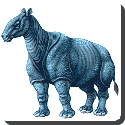 Baluchitherium — The correct Latin names for fossils in this group (the indricotheres) are a matter of uncertainty. It is also widely known as “Baluchitherium” (“beast of Baluchistan”), as it was first discovered in Baluchistan, western Province of Pakistan. This genus name, Baluchitherium Forster Cooper 1913, is now widely regarded as a synonym of his earlier genus Paraceratherium Forster Cooper 1911. However, the animal once widely known as Baluchitherium grangeri Osborn 1923 is now thought to be the same as Indricotherium transouralicum Pavlova 1922. The older species name takes priority.
Baluchitherium — The correct Latin names for fossils in this group (the indricotheres) are a matter of uncertainty. It is also widely known as “Baluchitherium” (“beast of Baluchistan”), as it was first discovered in Baluchistan, western Province of Pakistan. This genus name, Baluchitherium Forster Cooper 1913, is now widely regarded as a synonym of his earlier genus Paraceratherium Forster Cooper 1911. However, the animal once widely known as Baluchitherium grangeri Osborn 1923 is now thought to be the same as Indricotherium transouralicum Pavlova 1922. The older species name takes priority.
Indricotherium(“Baluchitherium”) is a genus of extinct mammals that lived in Asia during the late Oligocene and early Miocene epoch of the Tertiary Period (37-32 million years ago). The Indricotherium is the largest land mammal known. The mean size of adults is estimated to have been 5.2 m (18 ft) tall, 8.2 m (27 ft) in length and a weight of about 15 tons. It was a herbivore that stripped leaves from trees with its down-pointing, tusk-like upper teeth that occluded forward-pointing lower teeth. It had a long, low, hornless skull and vaulted frontal and nasal bones. Its front teeth were reduced to a single pair of incisors in either jaw, but they were conical and so large that they looked like small tusks. The upper incisors pointed straight downwards, while the lower ones jutted outwards. The upper lip was evidently extremely mobile. The neck was very long, the trunk robust, and the limbs long and thick, column-like.
These giant animals seem to have been limited to central Asia and southernmost parts of Pakistan, for their fossils have not been found elsewhere. Indricotherium inhabited dry grasslands with a few trees, where it congregated in small herds. Its type of dentition, its mobile upper lip and its long legs and neck indicate that it lived on the leaves and twigs of tall trees, which it cropped like present-day giraffes.
There is also disagreement over whether Indricotherium Borissiak 1915 is a distinct genus from Paraceratherium. Lucas and Sorbus 1989 argue for synonymy, and consider that the differences between the two are of species level at most, and may even be the result of sexual dimorphism in a single species, with the larger more robust Indricotherium with larger incisors being probably the male, and the more gracile Paraceratherium the female. Others, however, have expressed doubts about this (concerning the interpretation of the shape of the skull). Even if these two do turn out to be distinct genera, they would still be very similar in size and appearance.
 Kids Portal For Parents India Kids Network
Kids Portal For Parents India Kids Network
